- Basics of Hydroelectric Power
- Captures the kinetic energy of water flowing from higher to lower levels.
- Water flow turns a turbine, generating mechanical energy, converted into electricity by a generator.
- Energy is transmitted to substations, where voltage is “stepped up” for grid distribution.
- Advantages of Hydropower
- Renewable: Uses water without consuming it.
- Low Costs: Minimal recurring expenses.
- Clean Energy: Non-polluting and inflation-free (no fossil fuels).
- Reliable: Quick startup makes it suitable for peak load management.
- Economic Synergy: Complements thermal power for grid stability.
- Disadvantages of Hydropower
- High Capital Costs: Expensive to build.
- Environmental Impact: Deforestation, habitat loss, and displacement due to submergence.
- Geographic Limitation: Dams can only be built in specific locations.
- Land Use: Submerges agricultural and forest areas.
- Hydropower in India
- Global Rank: 5th largest hydropower capacity.
- Capacity (2020):
- Utility-scale: 46,000 MW (12.3% of total power).
- Small hydro: 4,683 MW (1.3% of total power).
- Potential:
- Large hydro: 148,700 MW (60% load factor).
- Small hydro: 21,135 MW from 7,135 sites.
- Key States: Arunachal Pradesh (47 GW potential), Uttarakhand (12 GW potential).
- Challenges: Slow project implementation, environmental concerns, land acquisition issues.

